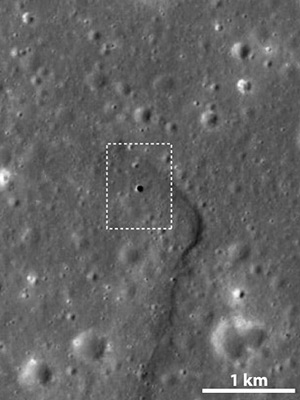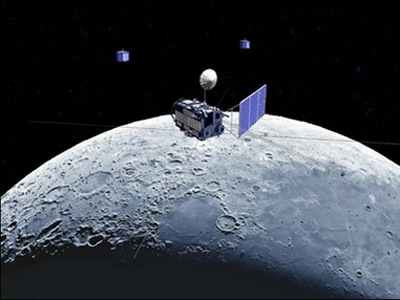Lava tube - a residence on the moon
The entrance of the newly discovered lava tube on the moon can lead us to a cozy shelter within the moon.
The Japanese spacecraft Kaguya has captured pictures of strange black holes that could be 'skylights' - the entrance of a large lava tube beneath the moon.

A 'skylight' has just been discovered by Japan's Kaguya spacecraft.
Junichi Haruyama of the Japan Aeronautics Agency (JAXA) said scientists have long sought to approach lava tubes on the moon because these are the caves that promise a natural residence on. moon.
Lava tubes can be a safe haven in the moon's harsh environment: meteor bombardments, cosmic radiation, and large temperature changes throughout the day at the moon.
Go underground
On Earth, lava tubes form after the eruption of volcanoes, when underground lava flows flow and leave traces of troughs. If a section above the lava tube is eroded or collapsed, it will create 'skylights'; This will be the entrance to the lava tube.

Kaguya spacecraft on orbit.
Scientists believe that the moon's volcanoes were active about 3 billion years ago. Scientists predict that lava tubes exist within the moon. However, scientists have not found any 'celestial wells' because viewed from the moon, it is difficult to distinguish them from craters.
From 12/2007 to 6/2009, the Kaguya spacecraft captured images of the entire moon with high resolution. Photos taken in May 2008 show a 'skylight' in the moon's Marius Hills volcano area.
JAXA's team analyzed several photographs of dark spots taken at the same time of the day and based on changes in darkness to calculate the depth of the detected dark spots.
Haruyama and his colleagues, in a speech in Geophysical Research Letters, said there is a hole about 88m deep - this hole is too deep to be a crater. Similarly, there is a 65m deep hole in the middle of the winding trail on the moon.
These traces can prove the existence of underground troughs that once had flowing lava flows and are now hollow tubes. According to scientists, the cave must be at least 370m wide.
Natural protection
Andrew Daga once studied the feasibility of using lava tubes to place coordination centers on the moon.

Lava Thurston at Hawaii Vocalnoes National Park of America.
He said the installation of facilities on the surface of the moon, whether fixed or mobile, is complex and expensive. In addition, no building is built on a surface that is strong enough to protect us better inside a lava tube. Lava tubes can also be used in the long term.
Based on the total number of nearby craters, Haruyama's team estimates that the lava tube's skylight was created more than 3.5 billion years ago. That means that any area of the lava tube is maintaining a good condition that cannot collapse.
Target landing the moon
The next step after the discovery of 'skylights' is to send a robot to perform key measurements such as the thickness of the volcanic rock above the moon cave. If the idea of a lunar shelter is grounded, the lava tube locations may be linked to potential water sources and other factors that provide a basis for human habitation.
In fact, the Marius Hills area has been proposed as a landing point during the period of Apollo. Currently, this landing point is also considered for NASA's constellation research program.
Haruyama said that volcanoes like Marius Hills are good places to find moon resources. Because the volcanic eruption on the moon creates a kind of glossy black volcanic rock, it is possible to exploit rare earth metals, silicon and oxygen. And now, scientists also think about placing coordination centers in caves in this area.
- Detecting 200 suspected water holes on the Moon
- Detecting giant lava tubes, can cause polarity to reverse the Earth's magnetic field
- The moon hole is that of an alien?
- People can live in lava dungeons on the Moon
- Hypothesis of black plate formation on the Moon
- Humans can stay in Mars and Moon caves
- The longest lava cave in Southeast Asia in Vietnam
- 'Lava moon' discovered outside the Solar System
- At the time of dinosaurs, volcanoes on the Moon used to work?
- The moon has water: Undeniable evidence
- The moon is the first new place for extraterrestrial humans?
- New technology retrieves Oxygen from lava lava
 Van Allen's belt and evidence that the Apollo 11 mission to the Moon was myth
Van Allen's belt and evidence that the Apollo 11 mission to the Moon was myth The levels of civilization in the universe (Kardashev scale)
The levels of civilization in the universe (Kardashev scale) Today Mars, the sun and the Earth are aligned
Today Mars, the sun and the Earth are aligned The Amazon owner announced a secret plan to build a space base for thousands of people
The Amazon owner announced a secret plan to build a space base for thousands of people